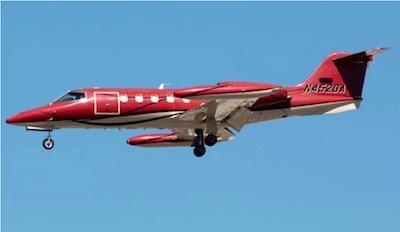Probable Cause Report Released For May 15, 2017 Accident
The National Transportation Safety Board determined during a public meeting held Tuesday that a pilot’s failure to perform a go-around when the approach became unstable, which resulted in a stall at low altitude, caused the May 15, 2017, crash of a Learjet near Teterboro Airport, New Jersey.

After departing controlled flight during a circle-to-land maneuver to the airport, the Learjet 35A crashed into a commercial building and parking lot, about a half mile from the intended runway. Both pilots, the only occupants aboard the aircraft, died in the crash.
In addition to failing to go around when the approach became unstabilized, the crew committed multiple errors, and repeatedly failed to comply with Trans-Pacific Jets’ standard operating procedures before and throughout the flight.
The NTSB determined the pilot-in-command’s preflight planning was inadequate. His flight plan contained an incompatible altitude for the planned 28-minute flight from Philadelphia to Teterboro. He also failed to secure weather information for the flight leg despite the company’s policy to do so within three hours of the flight.
Throughout the majority of the flight, the second-in-command was the pilot flying the airplane although he did not have the experience necessary to do so according to the company’s standard operating procedures. The pilot-in-command coached him extensively, interfering with his own pilot monitoring duties.
On approach, the crew failed to conduct the required approach briefing or complete any checklist, which would have reduced their workload and provided them with a shared understanding of how the approach should be flown. This resulted in the pilots’ confusion and led to mismanaging the approach and not initiating a circle-to-land maneuver when instructed by air traffic control.
NTSB Chairman Robert Sumwalt emphasized during the meeting that some safety programs used by commercial airline operators are not required for Part 135 aircraft operations, which include on-demand and commuter flights as well as air medical service, air taxi, and charter flights. “If operators of these flights were required to use the same tools as airline operators, accidents like this might not happen,” Sumwalt said. To help ensure a single, high level of safety in aviation, the NTSB made Improve the Safety of Part 135 Aircraft Flight Operations an item on the 2019-2020 Most Wanted List of Transportation Safety Improvements.
The NTSB report notes that although deficiencies were noted during the pilots’ initial training, the company did not monitor their subsequent performance to identify and correct continued deficiencies. Trans-Pacific Jets’ lack of safety programs that would have enabled the company to identify and correct patterns of poor performance and procedural noncompliance was a contributing factor in the crash.
Based on the findings in its investigation of the crash, the NTSB issued three new safety recommendations to the Federal Aviation Administration:
- Require programs for flight crewmembers with performance deficiencies or failures during training and administer additional oversight and training to correct performance deficiencies;
- Develop guidance for Part 135 operators to help them create and implement effective crew resource management training programs;
- Review Learjet operators’ manuals to determine whether they contain manufacturer-recommended approach speed wind additives and encourage those operators without that information to add it to their operations documents.
The NTSB also reiterated six recommendations addressing leadership training for upgrading captains, the installation flight data recording devices and implementation of flight data monitoring programs for Part 135 operators, the establishment of safety management systems for Part 135 operators, and procedures to identify Part 135 operators whose pilots do not comply with standard operating procedures.
(Image of accident airplane from NTSB docket)
 ANN's Daily Aero-Term (04.26.24): DETRESFA (Distress Phrase)
ANN's Daily Aero-Term (04.26.24): DETRESFA (Distress Phrase) ANN's Daily Aero-Linx (04.26.24)
ANN's Daily Aero-Linx (04.26.24) Airborne 04.22.24: Rotor X Worsens, Airport Fees 4 FNB?, USMC Drone Pilot
Airborne 04.22.24: Rotor X Worsens, Airport Fees 4 FNB?, USMC Drone Pilot Airborne 04.24.24: INTEGRAL E, Elixir USA, M700 RVSM
Airborne 04.24.24: INTEGRAL E, Elixir USA, M700 RVSM Airborne-NextGen 04.23.24: UAVOS UVH 170, magni650 Engine, World eVTOL Directory
Airborne-NextGen 04.23.24: UAVOS UVH 170, magni650 Engine, World eVTOL Directory



